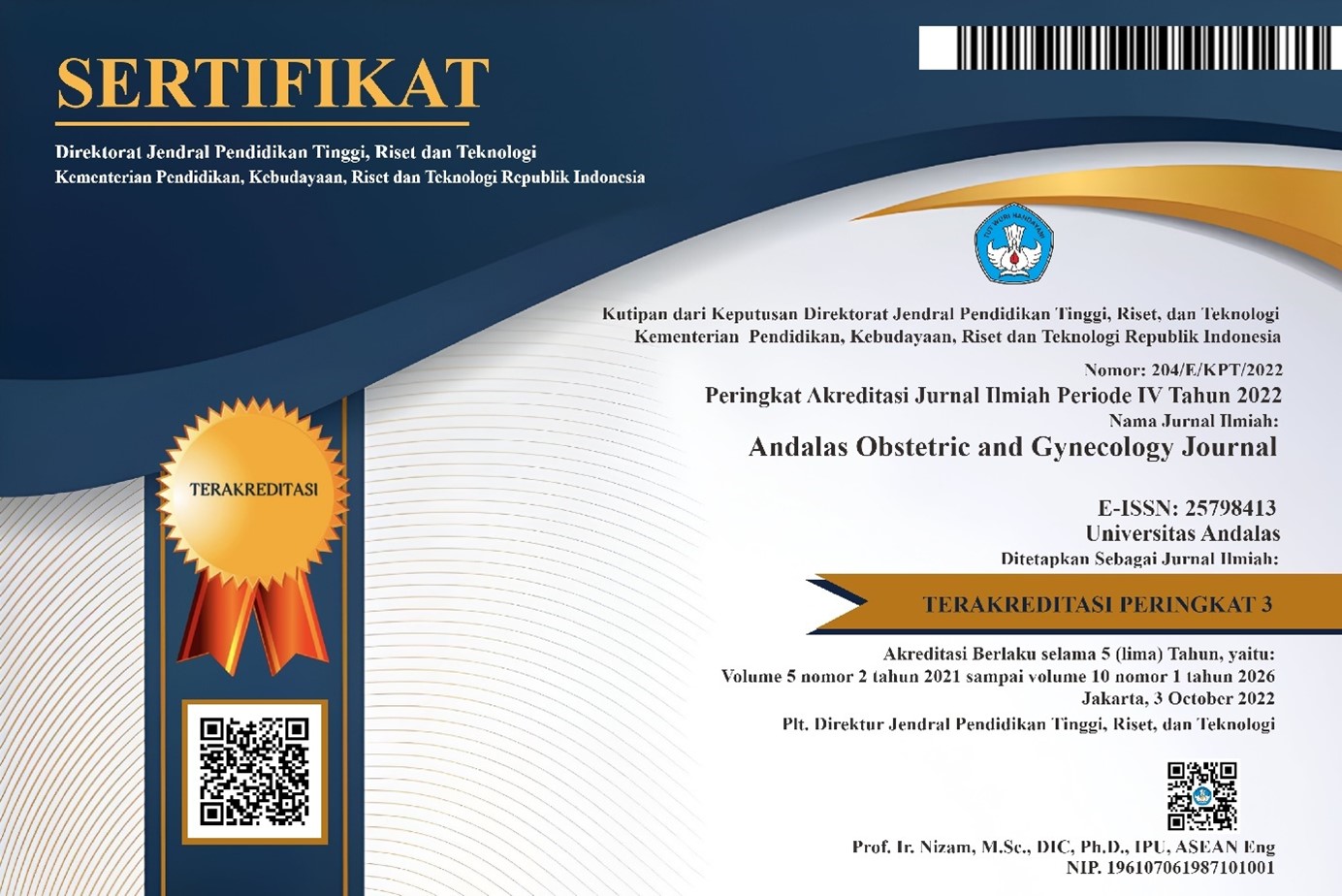MULTIGRAVIDA WITH UNCONTROLLED HYPERTHYROID AND BILATERAL PLEURAL EFFUSION
DOI:
https://doi.org/10.25077/aoj.4.2.167-172.2020Abstract
Background: Hyperthyroid is a hypermetabolic condition caused by abnormal thyroid gland function resulting in overproduction and overexpression of thyroid hormone. The prevalence of hyperthyroid during pregnancy is 0.1-0.4%, where 85% of case are presented as grave’s disease.
Objective: To report the treatment of uncontrolled hyperthyroid during pregnancy.
Method: Case Report
Case:Â Ms. S, Female, 33 years old, presenting with brethlessness since 5 days before admission. Breathlessness persist and aggravated by lying down position. The patient has history of hyperthyroid since 1 years before admission. The blood pressure was 120/80 mmHg, respiration rate 28 times/min, and body temperature 36,7oC. Uterus fundal height 26 cm, cephalic presentation, fetal heart rate 130 times/min, single fetus intrauterine and alive. Laboratoric test for leukocyte: 21,300/ul, T4 level 22.8 mg/dl dan T3 level 2.9 mg/dl. The patient diagnosed with G3P2A0 31-week gestational age single alive fetus intrauterine with uncontrolled hyperthyroid and bilateral pleural effusion. Treatment consist of propylthiouracil as the drug of choice for anti-thyroidal drug, nifedipine for gestational hypertension and furosemide to treat the pleural effusion.Â
Conclusion: History taking, physical examination, thyroid function test, and maintaining euthyroidism during pregnancy is a key to reduce the risk of maternal and fetal complication.
Keywords: hyperthyroid, pregnancy , IUGR
References
Prawirohardjo, S. Ilmu Kebidanan. Jakarta: PT. Bina Pustaka Sarwono Prawirohardjo. Cetakan ke-4. 2014.
Cui Y, Rijhsinghani A. Role of Maternal Thyroid-Stimulating Immunoglobulin in Graves’ Disease for Predicting Perinatal Thyroid Dysfunction. Am J Perinatol Rep. 2019 (9): 341–345.
Renzo, Gian. Good clinical practice advice: Thyroid and pregnancy. Int J Gynecol Obstet 2019. (144): 347–351
Andersen, Stine L. Laurberg, Peter. Managing hyperthyroidism in pregnancy: current perspective. International Journal of Women’s Health 2016 (8): 497–504
Kahaly, G et al. Guideline for the Management of Graves. Eur Thyroid J. 2018 (7) : 167–186.
Garry, D, Penyakit Tiroid Pada Kehamilan, CDK-206. 2013. (40) :500-503
Naraintran et al. Accuracy of Wayne’s criteria in diagnosing hyperthyroidism: a prospective study in south Kerala, India. Int Surg J. 2018 (4) :1267-1270
Wagh, R et al. Thyroid screening in pregnancy. Int J Reprod Contracept Obstet Gynecol. 2017 (9): 3956-3959
Nguyen et al. Graves’ hyperthyroidism in pregnancy: a clinical review. Clinical Diabetes and Endocrinology. 2018 (4): 1-4
Singh S, et al. A rare case of thyroid storm following caesarean section. Int J Reprod Contracept Obstet Gynecol. 2016;5(3):933-6
Alexander et al. Diagnosis and Management of Thyroid Disease During Pregnancy and the Postpartum. American Thyroid Association. 2017 (27): 315-389
Downloads
Published
Issue
Section
License
Copyright (c) 2020 JOURNAL OBGIN EMAS

This work is licensed under a Creative Commons Attribution 4.0 International License.
Copyright
Authors who publish with this journal agree to the following terms:
- Authors retain the copyright of published articles and grant the journal right of first publication with the work simultaneously licensed under a Creative Commons Attribution 4.0 International License that allows others to share the work with an acknowledgment of the work's authorship and initial publication in this journal.
- Authors are able to enter into separate, additional contractual arrangements for the non-exclusive distribution of the journal's published version of the work (e.g., post it to an institutional repository or publish it in a book), with an acknowledgment of its initial publication in this journal.
- Authors are permitted and encouraged to post their work online (e.g., in institutional repositories or on their website) prior to and during the submission process, as it can lead to productive exchanges, as well as earlier and greater citation of published work (See The Effect of Open Access).
License:
Andalas Obstetrics and Gynecology Journal (AOJ) is published under the terms of the Creative Commons Attribution 4.0 International License. This license permits anyone to copy and redistribute this material in any form or format, compose, modify, and make derivatives of this material for any purpose, including commercial purposes, as long as they credit the author for the original work.







